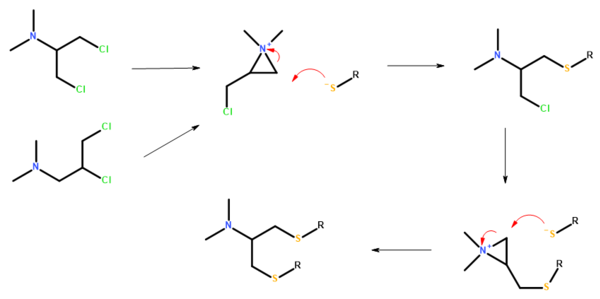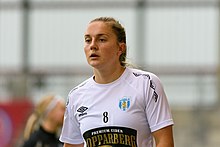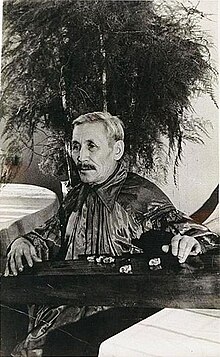네레이스톡신
Nereistoxin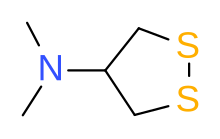 시리즈의 천연 제품 상위 | |
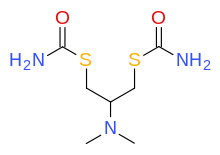 카르탑 | |
| 이름 | |
|---|---|
| 선호 IUPAC 이름 N,N-디메틸-1,2-디티올란-4-아민 | |
| 기타 이름 NTX | |
| 식별자 | |
| |
3D 모델(JSmol) | |
| 체비 |
|
| 켐스파이더 | |
| ECHA InfoCard | 100.121.136 |
| EC 번호 |
|
| 케그 | |
펍켐 CID | |
| 유니 |
|
CompTox 대시보드 (EPA) |
|
| |
| |
| 특성. | |
| C5H11NS2 | |
| 어금질량 | 149.27 g·190−1 |
달리 명시된 경우를 제외하고, 표준 상태(25°C [77°F], 100 kPa)의 재료에 대한 데이터가 제공된다. | |
| Infobox 참조 자료 | |
네레이스토신은 1962년 독성 유기화합물 N, N-디메틸-1,2-디티올란-4-아민으로 확인된 천연물이다. 1934년 처음으로 해양성 안네리드 룸브리코네리스 헤테로포다로부터 격리되어 니코틴성 아세틸콜린 수용체를 차단하는 작용을 했다.[1] 일본 다케다 연구진은 살충제일 가능성이 있는 것으로 조사했다. 그들은 이후에 ISO 공통 명칭인[4] bensultap,[5] cartap,[6] thiocyclam[7] 및 thiosultap을 포함하여 상용화된 많은 파생상품을 개발하였다.[2][3][8][9]
구조 및 합성
벤술탑(R=SOPh)2은 벤제네틸설폰산염(PhSOSNA2)의 나트륨 소금이 에탄올에 함유된 N, N-디클로로피-2-프로필아민 또는 N, N-디메틸2,3-디클로로피아민에 반응하여 만들어졌다.[9]
벤설탑은 알칼리로 치료하면 네레이스톡신으로 전환될 수 있다.[9]
역사
일본 어부들은 아넬리드 웜 룸브리코네리스 헤테로포다 마렌즈를 미끼로 사용했고, 우발적인 독극물 처리 후 책임 화학 물질이 확인되어 네레이스톡신이라는 이름을 붙였다.[10] 1960년대에 다케다 화학 공업의 연구자들은 활성 물질 N, N-디메틸-1,2-디티올란-4-아민과 디티올레인 링의 유황-황 결합을 대체 유황 연계 집단으로 대체한 파생 물질을 합성했다. 그 결과로 생긴 화합물은 많은 경우에 곤충에 대한 좋은 활동을 유지하면서 천연물보다 포유류에 덜 독성이 있었다. 그 후에 상업화된 모든 화합물들은 네레이스톡신이나 그것의 비사이클링 디티올에 대한 환경 파괴와 같은 예방제로서 작용한다는 것이 밝혀졌다.[11][12]
작용기전
네레이스톡신은 아세틸콜린과 화학적 유사성을 가지고 있으며 그 작용 방식은 원래 아세틸콜린에 대한 간섭에 의해 가능한 것으로 제안되었다. 이후 바퀴벌레 페리플라네타 아메리카나의 시냅스를 이용한 전기생리학 연구는 곤충 중추신경계 내 니코틴 아세틸콜린 수용체/이온채널 복합체를 차단해 작용하는 것으로 나타났다. 이것은 또한 관련 살충제의 작용 방식이기도 하며, 모두 모화합물에서 1,2-thiolane 링의 갈라짐에 해당하는 디티올을 생산할 수 있다.[12][13][14]
사용법
네레이스톡신의 살충제 유사물질 중 어느 것도 농업에서 주요 생산물이 된 것은 없으며 주로 일본과 중국의 쌀 재배에 한정되어 있었는데, 이때는 쌀줄기세포 칠로 억제와 같은 해충에 대한 통제가 상당했다.[9] 그들은 유럽이나 미국에서 사용할 수 있도록 허가되지 않았다. 이 화학 물질 그룹의 제한적인 성공은 부분적으로 다른 화합물들의 작용 방식은 비슷하지만 효력이 더 높고 포유류의 안전성이 더 높아졌기 때문이다.[15]
참조
- ^ Teuber, Lene (1990). "Naturally Occurring 1,2-Dithiolanes and 1,2,3-Trithianes. Chemical and Biological Properties". Sulfur Reports. 9 (4): 257–333. doi:10.1080/01961779008048732.
- ^ Roberts, Terry R; Hutson, David H, eds. (2007). "Nereistoxin precursors". Metabolic Pathways of Agrochemicals. pp. 127–138. doi:10.1039/9781847551375-00127. ISBN 978-0-85404-499-3.
- ^ Lewis, Kathleen A.; Tzilivakis, John; Warner, Douglas J.; Green, Andrew (2016). "An international database for pesticide risk assessments and management". Human and Ecological Risk Assessment. 22 (4): 1050–1064. doi:10.1080/10807039.2015.1133242. hdl:2299/17565. S2CID 87599872.
- ^ "Compendium of Pesticide Common Names". BCPC.
- ^ Pesticide Properties Database. "Bensultap". University of Hertfordshire.
- ^ Pesticide Properties Database. "Cartap". University of Hertfordshire.
- ^ Pesticide Properties Database. "Thiocyclam". University of Hertfordshire.
- ^ Pesticide Properties Database. "Thiosultap". University of Hertfordshire.
- ^ a b c d Konishi, Kazuo (1968). "New Insecticidally Active Derivatives of Nereistoxin". Agricultural and Biological Chemistry. 32 (5): 678–679. doi:10.1271/bbb1961.32.678.
- ^ Chiba, Sukehiro, et al. (1967). "Nereistoxin and its derivatives, their neuromuscular blocking and convulsive actions" (pdf). The Japanese Journal of Pharmacology. 17 (3): 491–492. doi:10.1254/jjp.17.491. PMID 4384262.
- ^ Lee, Seog-Jong; Caboni, Pierluigi; Tomizawa, Motohiro; Casida, John E. (2004). "Cartap Hydrolysis Relative to Its Action at the Insect Nicotinic Channel". Journal of Agricultural and Food Chemistry. 52 (1): 95–98. doi:10.1021/jf0306340. PMID 14709019.
- ^ a b Casida, John E.; Durkin, Kathleen A. (2013). "Neuroactive Insecticides: Targets, Selectivity, Resistance, and Secondary Effects". Annual Review of Entomology. 58: 99–117. doi:10.1146/annurev-ento-120811-153645. PMID 23317040.
- ^ Sattelle, DB, et al. (1985). "Nereistoxin: Actions on a CNS Acetylcholine Receptor / Ion Channel in the Cockroach Periplaneta Americana" (PDF). Journal of Experimental Biology. 118: 37–52.
- ^ Copping, Leonard G; Hewitt, H. Geoffrey, eds. (1998). "Insecticides". Chemistry and Mode of Action of Crop Protection Agents. pp. 46–73. doi:10.1039/9781847550422-00046. ISBN 978-0-85404-559-4.
- ^ Jeschke, Peter; Nauen, Ralf; Beck, Michael Edmund (2013). "Nicotinic Acetylcholine Receptor Agonists: A Milestone for Modern Crop Protection". Angewandte Chemie International Edition. 52 (36): 9464–9485. doi:10.1002/anie.201302550. PMID 23934864.
추가 읽기
- Godfrey, C. R. A. (17 November 1994). Agrochemicals from Natural Products. ISBN 0824795539.
외부 링크
| 위키미디어 커먼즈에는 벤설탑과 관련된 미디어가 있다. |



